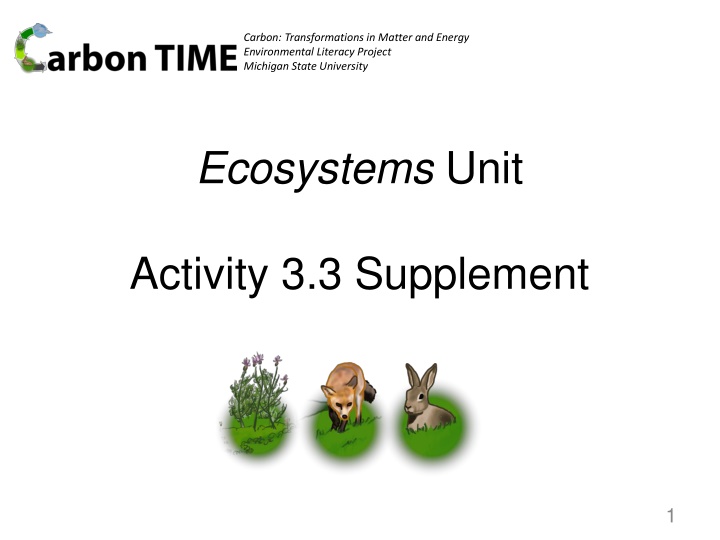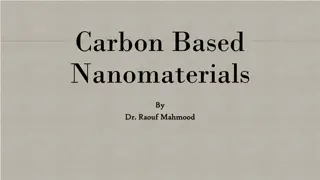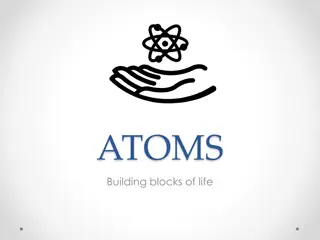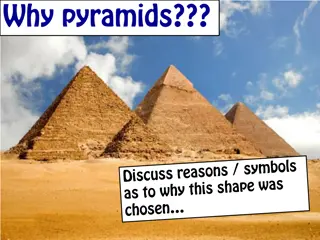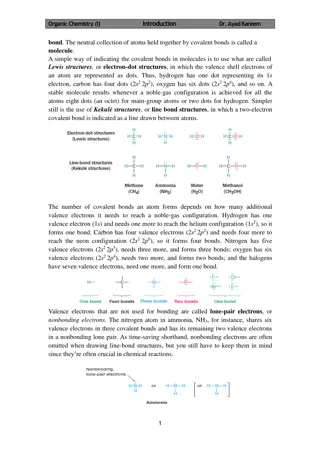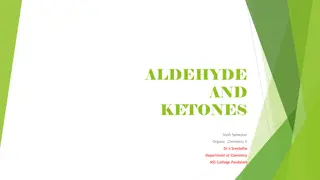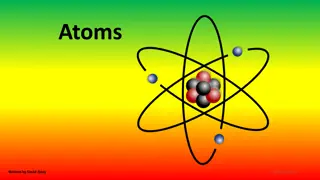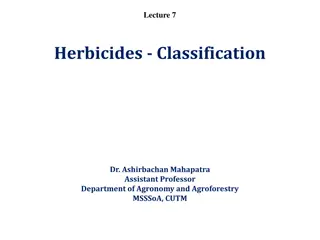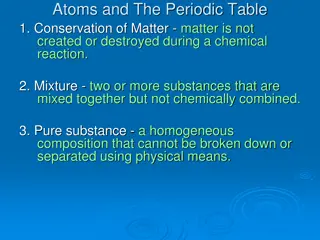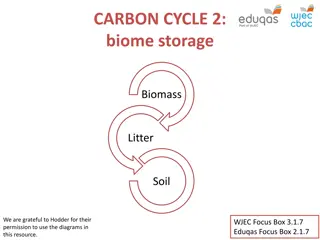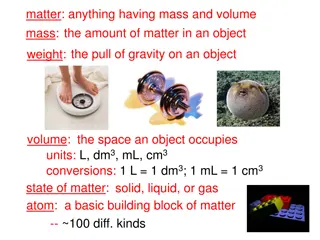Tracing Carbon Atoms in Ecosystems: Understanding the Organic Matter Pyramid
Explore the journey of 500 carbon atoms through producers, herbivores, and carnivores in an ecosystem. Discover how carbon atoms move through photosynthesis, cellular respiration, and biosynthesis, ultimately contributing to the organic matter pyramid. Follow the pathways of carbon atoms as they cycle between the atmosphere, soil, and living organisms, highlighting the interconnectedness of carbon in ecosystems.
Download Presentation

Please find below an Image/Link to download the presentation.
The content on the website is provided AS IS for your information and personal use only. It may not be sold, licensed, or shared on other websites without obtaining consent from the author.If you encounter any issues during the download, it is possible that the publisher has removed the file from their server.
You are allowed to download the files provided on this website for personal or commercial use, subject to the condition that they are used lawfully. All files are the property of their respective owners.
The content on the website is provided AS IS for your information and personal use only. It may not be sold, licensed, or shared on other websites without obtaining consent from the author.
E N D
Presentation Transcript
Carbon: Transformations in Matter and Energy Environmental Literacy Project Michigan State University Ecosystems Unit Activity 3.3 Supplement 1
How can we explain the organic matter pyramid by tracing carbon atoms through the ecosystem? atoms through the ecosystem? Let's follow 500 carbon atoms How can we explain the organic matter pyramid by tracing carbon The organic matter pyramid: Comparing the organic matter of producers, herbivores, and carnivores. through the ecosystem. Carnivores 110 In these slides we are counting individual carbon atoms, but real ecosystems have far too many carbon atoms to count. For example, the organic matter of a small meadow contains more than Note: The pathways of carbon atoms are the same in all ecosystems, but the numbers of atoms are different. 10,000,000,000,000,000,000,000,000,000 carbon atoms! Atmosphere Herbivores 100 Producers Soil Carbon 2
What happens to carbon atoms in producers? - Photosynthesis Carnivores - Cellular Respiration/Biosynthesis 200 carbon atoms go back to the atmosphere when plants use the sugar for cellular respiration. 100 110 120 130 140 150 160 170 180 190 200 100 110 120 130 140 150 160 170 180 190 200 210 220 230 240 250 260 270 280 290 300 310 320 330 340 350 360 370 380 390 400 410 420 430 440 450 460 470 480 490 500 10 20 30 40 50 60 70 80 90 10 20 30 40 50 60 70 80 90 0 - Being Eaten/Death Note: The pathways of carbon atoms are the same in all ecosystems, but the numbers of atoms are different. Atmosphere 100 10 20 30 40 50 60 70 80 90 Herbivores 500 carbon atoms become part of sugar molecules through photosynthesis. 10 20 30 40 50 60 70 80 90 100 100 carbon atoms go 100 carbon atoms go to herbivores when they eat plants. 300 carbon atoms become part of the plant through biosynthesis. 100 carbon atoms stay in the living plants. 10 20 30 40 50 60 70 80 90 230 240 250 260 270 280 290 300 310 320 330 340 350 360 370 380 390 400 410 420 430 440 450 460 470 480 490 500 100 110 120 130 140 150 160 170 180 190 200 210 220 100 Soil Carbon to the soil when plants or leaves die. Producers 3
Note: The pathways of carbon atoms are the same in all ecosystems, but the numbers of atoms are different. 15 carbon atoms go to carnivores when they eat herbivores. What happens to carbon atoms in producers? in herbivores? What happens to carbon atoms 1 2 3 4 5 6 7 8 9 10 11 12 13 14 15 - Undigested food/Defecation Carnivores - Cellular Respiration/Biosynthesis 10 200 210 220 230 240 250 - Being Eaten/Death 34 carbon atoms become part of the herbivore through biosynthesis. herbivores. Atmosphere 50 carbon atoms go back to the atmosphere when herbivores use the food for cellular respiration. herbivores defecate. herbivores die. 10 carbon atoms stay in the living 100 99 98 97 96 95 94 93 92 91 90 89 88 87 86 85 84 74 64 54 44 34 33 32 31 30 29 28 27 26 25 24 23 22 21 20 19 18 17 16 15 14 13 12 11 10 Herbivores 9 carbon atoms go to 16 carbon atoms go to the soil when the soil when 100 carbon atoms go to herbivores when they eat plants. 100 carbon atoms stay in the living plants. 100 100 101 102 103 104 105 106 107 108 109 110 111 112 113 114 115 116 117 118 119 120 121 122 123 124 125 100 carbon atoms go 100 Soil Carbon to the soil when plants die. Producers 4
Note: The pathways of carbon atoms are the same in all ecosystems, but the numbers of atoms are different. atmosphere when carnivores use the food for cellular respiration. What happens to carbon atoms in herbivores? in carnivores? What happens to carbon atoms 8 carbon atoms go back to the 1 carbon atom stays in the living carnivores. when they eat herbivores. 15 carbon atoms go to carnivores 15 14 13 12 11 10 9 8 7 6 5 4 3 2 1 - Undigested food/Defecation 3 carbon atoms Carnivores become part of carnivores through - Cellular Respiration/Biosynthesis 110 biosynthesis. 250 251 252 253 254 255 256 257 258 - Death Atmosphere 10 carbon atoms stay in the living herbivores. 10 4 carbon atoms go to the soil when carnivores defecate. carnivores die. 2 carbon atoms go to the soil when Herbivores 9 carbon atoms go to the soil when herbivores die. 100 125 126 127 128 129 130 131 100 Producers Soil Carbon 5
Note: The pathways of carbon atoms are the same in all ecosystems, but the numbers of atoms are different. What happens to carbon atoms in carnivores? in the soil? What happens to carbon atoms 1 carbon atom stays in the living carnivores. 1 - Cellular Respiration/Biosynthesis Carnivores 110 258 259 269 279 289 299 309 319 324 Atmosphere 66 carbon atoms go back to the atmosphere when decomposers use 10 6 carbon atoms go to the soil when carnivores die. the soil carbon for cellular respiration. Herbivores 100 131 130 120 110 100 90 80 70 65 100 65 carbon atoms stay in the soil. Producers Soil Carbon 6
Note: The pathways of carbon atoms are the same in all ecosystems, but the numbers of atoms are different. How can we explain the organic matter pyramid by tracing carbon atoms through the ecosystem? Carnivores 110 Plants, animals, and decomposers create the organic matter pyramid through their carbon-transforming processes-- when they photosynthesize, eat, grow, live, and die. Atmosphere Herbivores 100 Producers Soil Carbon 7
